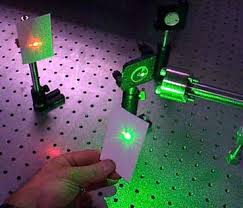| |
 |
|
|
|
| |
A versatile spectroscopy

Raman spectroscopy is based on inelaxtic light scattering, which means that laser light can exchange energy with molecules by changing their vibrational state. One can measure the vibrational frequencies by measuring the frequency (or wave number) shift in the scattered light. This method for determining the vibrational modes of molecules has a large number of applications due to the versatility of laser excitation. One can use the laser in beam in a microscopy, in a fiber, in air and even projected into the stratosphere in order to obtain information from the scattered light collected in each of these geometires. Raman spectroscopy contains more information that just the frequency of the vibration. The degree of depolarization (which is defined as parallel light divided by perpendicular scattered light) can be used to determine whether a given mode is totally symmetry or non-totally symmetric. This is quite a bit of information for such a simple measurement. This is especially power when you consider that a modern Raman spectrometer permits measurement of most if not all of the vibrations of a molecule in one measurement.
The laboratory protocol can be downloaded below:
General background the FC factor in spectroscopy is useful
The Raman lecture notes provide information on the depolarization ratio and the fundamentals of resonance Raman
One interesting aspect of Raman spectroscopy is that it can be readily compared to calculations obtained from quantum chemical methods. The files below are structures and output files from CCl4 and C6H12, which are the two solvent molecules we will study. Both CCl4 and cyclohexane can be considered as Raman standards for calibration and as useful molecules for tweaking up the spectrometer.
Output from DFT calculations
References
|
| |